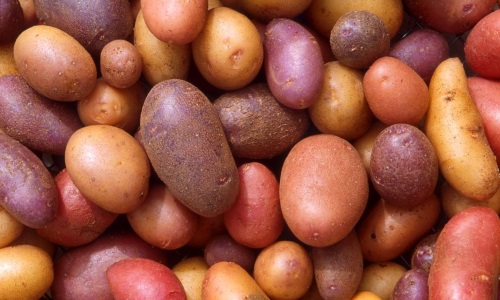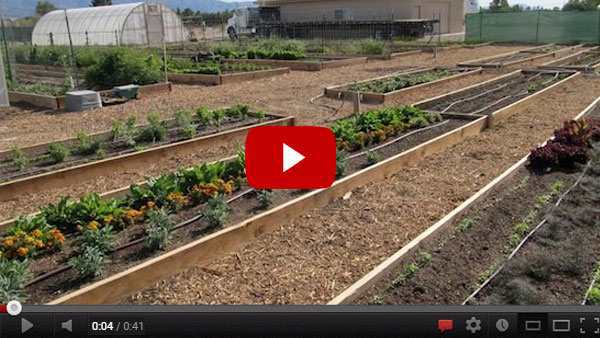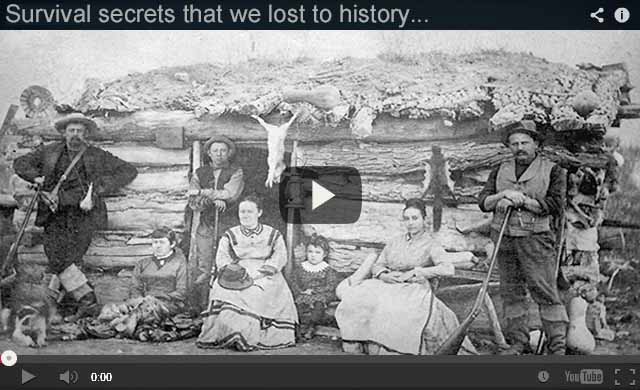Genetically-Engineered Potatoes
Over the last few years, potatoes have been losing importance as a food crop. The crop’s prospects in the starch and chemical industry, however, have been growing for quite some time. For starch potatoes, taste isn’t what’s important. Instead, emphasis is placed on the quality and composition of the starch. An optimised starch potato could be making its way to fields in Europe soon. This new potato cultivar is genetically modified.
Producing stable food yields for a growing world population is a major challenge for agriculture. Soil erosion, water shortages, climate change and shrinking farmland pose serious threats to essential resources, while human needs continue to grow. But what is the concept behind sustainability and can GM crops (e.g. herbicide tolerant soybeans) help us move towards a sustainable form of agriculture?
Some have seen this problem coming for a long time and changed their entire way of life by going off-grid. They have found alternative sources such as solar, wind and diesel to power their homes and machinery. A majority of us, who have not gone off-grid, are making a concerted effort to avoid dependence on this ailing infrastructure and preparing for life without it.
VIA : abcnews.go.com
Three types of potatoes genetically engineered to resist the pathogen that caused the Irish potato famine are safe for the environment and safe to eat, federal officials have announced.
The approval by the U.S. Environmental Protection Agency and the U.S. Food and Drug Administration late last week gives Idaho-based J.R. Simplot Company permission to plant the potatoes this spring and sell them in the fall.
The company said the potatoes contain only potato genes, and that the resistance to late blight, the disease that caused the Irish potato famine, comes from an Argentine variety of potato that naturally produced a defense.
The three varieties are the Russet Burbank, Ranger Russet and Atlantic. They’ve previously been approved by the U.S. Department of Agriculture.
All three varieties “have the same taste and texture and nutritional qualities” as conventional potatoes, said Simplot spokesman Doug Cole.
Late blight thrives in the type of wetter conditions that led to the Irish potato famine in the 1840s. Potatoes were a main staple, but entire crops rotted in the field. Historical records say about a million people died of starvation and disease, and the number of Irish who emigrated might have reached several million.
Potatoes in modern times are considered the fourth food staple crop in the world behind corn, rice and wheat. Late blight continues to be a major problem for potato growers, especially in wetter regions. Fungicides have been used for decades to prevent the blight.
Simplot says the genetically engineered potatoes reduce the use of fungicide by half.
The company said the potatoes will also have reduced bruising and black spots, enhanced storage capacity, and a reduced amount of a chemical created when potatoes are cooked at high temperatures that’s a potential carcinogen.
Conventional potatoes can turn a dark color when cooked after they were kept cold for too long, a problem Simplot said the three new varieties reduce. The company also said the enhanced cold storage will likely have significant ramifications for the potato chip industry by reducing trucking costs.
There is no evidence that genetically modified organisms, known as GMOs, are unsafe to eat, but for some people, altering the genetic code of foods presents an ethical issue. McDonald’s continues to decline to use Simplot’s genetically engineered potatoes for its French fries.
Simplot often notes the potatoes contain only potato genes, and not DNA from an unrelated organism. Organisms that contain DNA from an unrelated organism are defined as transgenic.
The Washington state-based Non-GMO Project that opposes GMOs and verifies non-GMO food and products said Simplot’s new potatoes don’t qualify as non-GMO.
“There is a growing attempt on the part of biotechnology companies to distance themselves from the consumer rejection of GMOs by claiming that new types of genetic engineering … are not actually genetic engineering,” the group said in a statement.
The most recent federal approvals apply to Simplot’s second generation of Innate potatoes. The first generation that went through the federal approval process didn’t include protection from late blight or enhanced cold storage.
The first generation of Innate potatoes has been sold in stores under the White Russet label. Cole said the company hasn’t decided how it will market the second generation.
The company is currently at work on a third generation that Cole said will have protections against additional strains of late blight, all coming from genes within the potato species.
RELATED : Grow Sweet Potatoes — Even in the North
Resistance to pests and diseases
Attempts to confer pest and disease resistance to potatoes using genetic engineering haven’t been quite as successful.
-
Several GM potato cultivars with improved resistance to viruses and to the potato beetle have been approved in the US and in Canada. In 1999, they were planted on approximately 25,000 hectares. Since then, cultivation of GM potatoes has ceased. The GM potatoes did not prevail, because they were not delivering any economic advantages, and some larger US companies refused to take the GM potatoes for further processing.
-
Right now, work is being done on potatoes with genetic engineering to confer resistance to
 Phytophthora infestans, also known as late blight of potato. Some consider this to be the most dangerous plant disease of all because it can spread extremely rapidly when conditions are warm and moist, leading to devastating losses. The disease is best known for causing the Irish Potato Famine of 1846-1850. Today, the disease is still a major problem. Owing to its flexibility, the disease has been able to survive every management strategy used thus far and has responded with new, adapted forms. Today, the disease is combatted using fungicides and heavy metal treatments. In the meantime, genetic engineers have come up with a promising new strategy. The first field trials with fungus resistant GM potatoes are already underway. The next few years will show if this new concept is effective.
Phytophthora infestans, also known as late blight of potato. Some consider this to be the most dangerous plant disease of all because it can spread extremely rapidly when conditions are warm and moist, leading to devastating losses. The disease is best known for causing the Irish Potato Famine of 1846-1850. Today, the disease is still a major problem. Owing to its flexibility, the disease has been able to survive every management strategy used thus far and has responded with new, adapted forms. Today, the disease is combatted using fungicides and heavy metal treatments. In the meantime, genetic engineers have come up with a promising new strategy. The first field trials with fungus resistant GM potatoes are already underway. The next few years will show if this new concept is effective.
Survival Food Prepping Ideas/ULTIMATE Top Skills 2017
Discover how to survive: Most complete survival tactics, tips, skills and ideas like how to make pemmican, snow shoes, knives, soap, beer, smoke houses, bullets, survival bread, water wheels, herbal poultices, Indian round houses, root cellars, primitive navigation, and much more at: The Lost Ways
The Lost Ways is a far-reaching book with chapters ranging from simple things like making tasty bark-bread-like people did when there was no food-to building a traditional backyard smokehouse… and many, many, many more!
Here’s just a glimpse of what you’ll find in The Lost Ways:
From Ruff Simons, an old west history expert and former deputy, you’ll learn the techniques and methods used by the wise sheriffs from the frontiers to defend an entire village despite being outnumbered and outgunned by gangs of robbers and bandits, and how you can use their wisdom to defend your home against looters when you’ll be surrounded.
Native American ERIK BAINBRIDGE – who took part in the reconstruction of the native village of Kule Loklo in California, will show you how Native Americans build the subterranean roundhouse, an underground house that today will serve you as a storm shelter, a perfectly camouflaged hideout, or a bunker. It can easily shelter three to four families, so how will you feel if, when all hell breaks loose, you’ll be able to call all your loved ones and offer them guidance and shelter? Besides that, the subterranean roundhouse makes an awesome root cellar where you can keep all your food and water reserves year-round.
From Shannon Azares you’ll learn how sailors from the XVII century preserved water in their ships for months on end, even years and how you can use this method to preserve clean water for your family cost-free.
Mike Searson – who is a Firearm and Old West history expert – will show you what to do when there is no more ammo to be had, how people who wandered the West managed to hunt eight deer with six bullets, and why their supply of ammo never ran out. Remember the panic buying in the first half of 2013? That was nothing compared to what’s going to precede the collapse.
From Susan Morrow, an ex-science teacher and chemist, you’ll master “The Art of Poultice.” She says, “If you really explore the ingredients from which our forefathers made poultices, you’ll be totally surprised by the similarities with modern medicines.” Well…how would you feel in a crisis to be the only one from the group knowledgeable about this lost skill? When there are no more antibiotics, people will turn to you to save their ill children’s lives.
If you liked our video tutorial on how to make Pemmican, then you’ll love this: I will show you how to make another superfood that our troops were using in the Independence war, and even George Washington ate on several occasions. This food never goes bad. And I’m not talking about honey or vinegar. I’m talking about real food! The awesome part is that you can make this food in just 10 minutes and I’m pretty sure that you already have the ingredients in your house right now.
Really, this is all just a peek.
The Lost Ways is a far-reaching book with chapters ranging from simple things like making tasty bark-bread-like people did when there was no food-to building a traditional backyard smokehouse… and many, many, many more!
And believe it or not, this is not all…
Table Of Contents:
The Most Important Thing
Making Your Own Beverages: Beer to Stronger Stuff
Ginger Beer: Making Soda the Old Fashioned Way
How North American Indians and Early Pioneers Made Pemmican
Spycraft: Military Correspondence During The 1700’s to 1900’s
Wild West Guns for SHTF and a Guide to Rolling Your Own Ammo
How Our Forefathers Built Their Sawmills, Grain Mills,and Stamping Mills
How Our Ancestors Made Herbal Poultice to Heal Their Wounds
What Our Ancestors Were Foraging For? or How to Wildcraft Your Table
How Our Ancestors Navigated Without Using a GPS System
How Our Forefathers Made Knives
How Our Forefathers Made Snow shoes for Survival
How North California Native Americans Built Their Semi-subterranean Roundhouses
Our Ancestors’Guide to Root Cellars
Good Old Fashioned Cooking on an Open Flame
Learning from Our Ancestors How to Preserve Water
Learning from Our Ancestors How to Take Care of Our Hygiene When There Isn’t Anything to Buy
How and Why I Prefer to Make Soap with Modern Ingredients
Temporarily Installing a Wood-Burning Stove during Emergencies
Making Traditional and Survival Bark Bread…….
Trapping in Winter for Beaver and Muskrat Just like Our Forefathers Did
How to Make a Smokehouse and Smoke Fish
Survival Lessons From The Donner Party
Books can be your best pre-collapse investment.
The Lost Ways (Learn the long forgotten secrets that helped our forefathers survive famines,wars,economic crisis and anything else life threw at them)
Survival MD (Best Post Collapse First Aid Survival Guide Ever)
Conquering the coming collapse (Financial advice and preparedness )
Liberty Generator (Build and make your own energy source)
Backyard Liberty (Easy and cheap DIY Aquaponic system to grow your organic and living food bank)
Bullet Proof Home (A Prepper’s Guide in Safeguarding a Home )
Family Self Defense (Best Self Defense Strategies For You And Your Family)
Survive Any Crisis (Best Items To Hoard For A Long Term Crisis)
Survive The End Days (Biggest Cover Up Of Our President)
Drought USA (Discover The Amazing Device That Turns Air Into Water)




